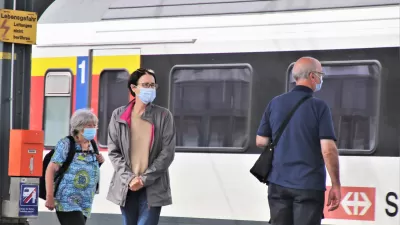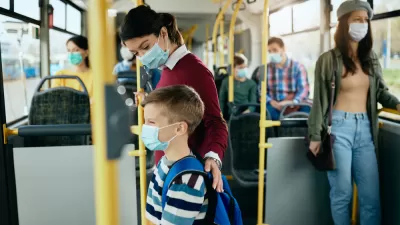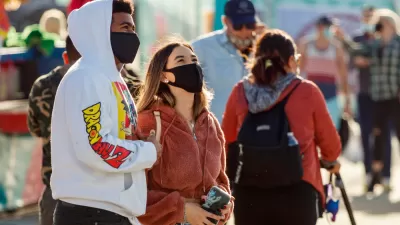Blue states have joined red ones in ending masking orders as COVID cases plummet, but the Centers for Disease Control and Prevention is sticking to its guidance: where transmission is 'high' or 'substantial,' universal indoor masking is recommended.

COVID cases are dropping dramatically in all but two territories in the U.S. on Feb. 9, down 63% in the last two weeks to a 7-day daily average of <230,000 cases, or 69 per 100,000 people, according to The New York Times coronavirus tracker. The Covid Act Now tracker on Feb. 10 shows that the infection rate, or R(t), is below 1 in all but one of its 53 jurisdictions, meaning the trajectory is downward everywhere save the Northern Mariana Islands.
That trajectory has contributed to the decision by many Democratic governors to lift their state's masking orders, as NBC News reported on Tuesday, Feb. 8:
Connecticut, Delaware, New Jersey and Oregon announced Monday that masks will soon no longer be required in schools. California Gov. Gavin Newsom will let the state’s indoor masking mandate end for vaccinated people on Feb. 15, although schoolchildren and the unvaccinated will still need to wear masks.
Bloomberg News reports on Wednesday that "New York Governor Kathy Hochul is lifting a mask mandate for businesses that don’t check Covid-19 vaccination status, citing high inoculation rates and low transmissions across the state."
NBC Chicago reports on Feb. 9 that "Gov. J.B. Pritzker announced Wednesday that the state plans to end its mask mandate for most indoor spaces by Feb. 28, with schools and health care facilities following suit at a later date." Massachusetts Gov. Charlie Baker, a Republican, announced the same day that masks will no longer be required in schools as of Feb. 28, reports the Boston Globe.
Coronavirus transmission
However, transmission, as measured in daily new cases, is high virtually everywhere in the U.S., as Rochelle Walensky, the director of the U.S. Center for Disease Control and Prevention (CDC), told Reuters on Tuesday.
"Now is not the moment to drop mask mandates in schools and other public places," Walenksy said in an interview, wrote Julie Steenhuysen and Carl O'donnell on Feb. 8. According to Walensky,
I know people are interested in taking masks off. I too am interested. That would be one marker that we have much of the pandemic behind us.
We have and continue to recommend masking in areas of high and substantial transmission - that is essentially everywhere in the country in public indoor settings.
Pandemic déjà vu
We've been here before—more than once, in fact. "High and substantial transmission" is the metric that the CDC applied to its recommendation for universal indoor masking (regardless of vaccination status) when it revised its masking guidance last summer after data from Provincetown, Mass. showed massive breakthrough infections.
[Scroll down to the section titled, "Do you live in an "area of substantial or high transmission?" in the post, "Delta Variant's High Transmissibility Prompts CDC to Issue Masking Correction," August 2, 2021.
. Two metrics are used to determine the level of transmission:
- Weekly new cases per 100,000 people, aka case incidence
- COVID-19 test positivity rate (TPR)]
CDC's COVID-19 Integrated County View map shows that for the week ending Feb. 9, 98.7% of counties are experiencing high transmission, 0.65% substantial transmission, 0.12% moderate transmission, and 0.5% low transmission.
Current CDC guidance
As of Aug. 12, 2021, CDC recommends that to "Slow the Spread of COVID-19, people, including children older than 2, should wear a mask in indoor public places if they are:
- Not fully vaccinated
- Fully vaccinated and in an area with substantial or high transmission
- Fully vaccinated and with weakened immune systems
Next steps
POLITICO reports on Wednesday that CDC is considering using other metrics, such as hospital capacity, to influence its masking guidance.
On a more general level, NBC News reports on Friday on the difficulties the administration is having from shifting from President Biden's promise as a candidate to "shut down the virus" to living with it.
Related in Planetizen:
Hat tip to Kaiser Health News Morning Briefings: Feb. 9 and Feb. 10.
FULL STORY: U.S. CDC stands by K-12 school masking guidance as states relax rules –Walensky

Planetizen Federal Action Tracker
A weekly monitor of how Trump’s orders and actions are impacting planners and planning in America.

Maui's Vacation Rental Debate Turns Ugly
Verbal attacks, misinformation campaigns and fistfights plague a high-stakes debate to convert thousands of vacation rentals into long-term housing.

Restaurant Patios Were a Pandemic Win — Why Were They so Hard to Keep?
Social distancing requirements and changes in travel patterns prompted cities to pilot new uses for street and sidewalk space. Then it got complicated.

In California Battle of Housing vs. Environment, Housing Just Won
A new state law significantly limits the power of CEQA, an environmental review law that served as a powerful tool for blocking new development.

Boulder Eliminates Parking Minimums Citywide
Officials estimate the cost of building a single underground parking space at up to $100,000.

Orange County, Florida Adopts Largest US “Sprawl Repair” Code
The ‘Orange Code’ seeks to rectify decades of sprawl-inducing, car-oriented development.
Urban Design for Planners 1: Software Tools
This six-course series explores essential urban design concepts using open source software and equips planners with the tools they need to participate fully in the urban design process.
Planning for Universal Design
Learn the tools for implementing Universal Design in planning regulations.
Heyer Gruel & Associates PA
JM Goldson LLC
Custer County Colorado
City of Camden Redevelopment Agency
City of Astoria
Transportation Research & Education Center (TREC) at Portland State University
Jefferson Parish Government
Camden Redevelopment Agency
City of Claremont





























